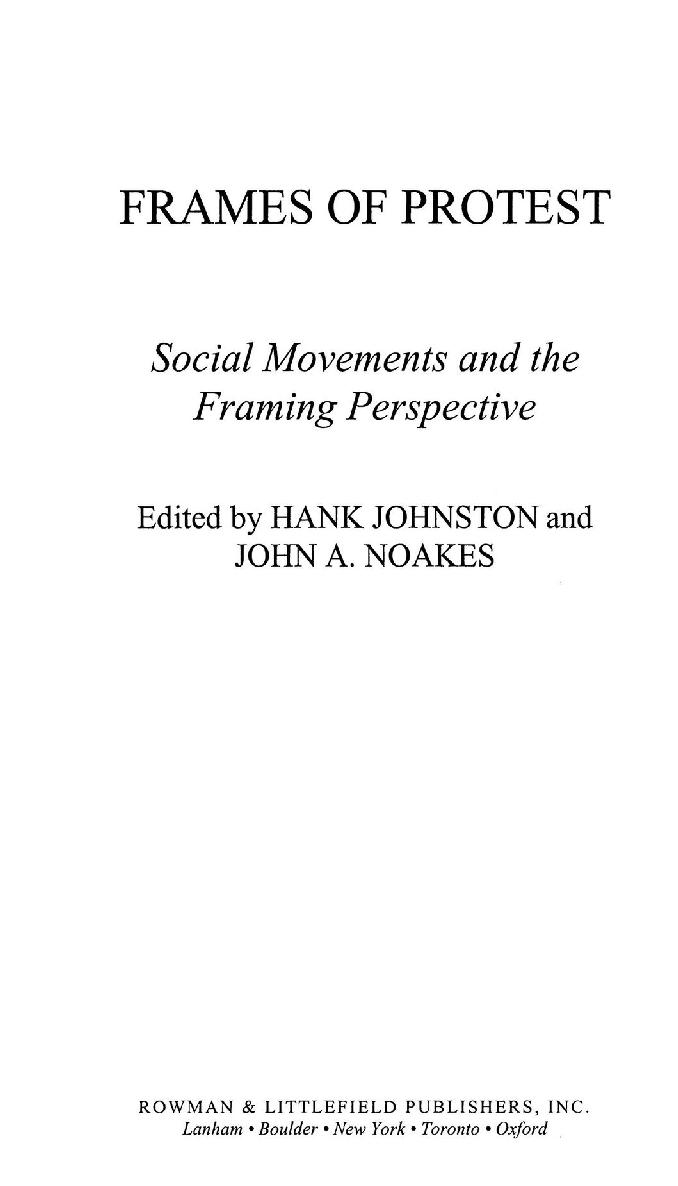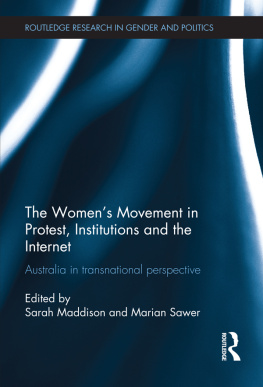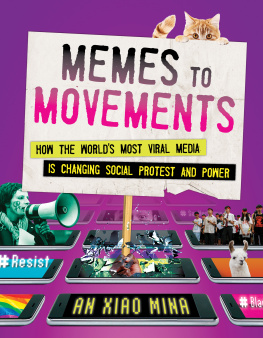Hank Johnston - Frames of Protest: Social Movements and the Framing Perspective
Here you can read online Hank Johnston - Frames of Protest: Social Movements and the Framing Perspective full text of the book (entire story) in english for free. Download pdf and epub, get meaning, cover and reviews about this ebook. year: 2005, publisher: Rowman & Littlefield Publishers, genre: Politics. Description of the work, (preface) as well as reviews are available. Best literature library LitArk.com created for fans of good reading and offers a wide selection of genres:
Romance novel
Science fiction
Adventure
Detective
Science
History
Home and family
Prose
Art
Politics
Computer
Non-fiction
Religion
Business
Children
Humor
Choose a favorite category and find really read worthwhile books. Enjoy immersion in the world of imagination, feel the emotions of the characters or learn something new for yourself, make an fascinating discovery.

- Book:Frames of Protest: Social Movements and the Framing Perspective
- Author:
- Publisher:Rowman & Littlefield Publishers
- Genre:
- Year:2005
- Rating:3 / 5
- Favourites:Add to favourites
- Your mark:
- 60
- 1
- 2
- 3
- 4
- 5
Frames of Protest: Social Movements and the Framing Perspective: summary, description and annotation
We offer to read an annotation, description, summary or preface (depends on what the author of the book "Frames of Protest: Social Movements and the Framing Perspective" wrote himself). If you haven't found the necessary information about the book — write in the comments, we will try to find it.
Frames of Protest: Social Movements and the Framing Perspective — read online for free the complete book (whole text) full work
Below is the text of the book, divided by pages. System saving the place of the last page read, allows you to conveniently read the book "Frames of Protest: Social Movements and the Framing Perspective" online for free, without having to search again every time where you left off. Put a bookmark, and you can go to the page where you finished reading at any time.
Font size:
Interval:
Bookmark:

ROWMAN & LITTLEFIELD PUBLISHERS, INC.
Published in the United States of America
by Rowman & Littlefield Publishers, Inc.
A wholly owned subsidiary of The Rowman & Littlefield Publishing Group, Inc.
4501 Forbes Boulevard, Suite 200, Lanham, Maryland 20706
www.rowmanlittlefield.com
P.O. Box 317, Oxford OX2 9RU, UK
Copyright 2005 by Rowman & Littlefield Publishers, Inc.
All rights reserved. No part of this publication may be reproduced, stored in a retrieval system, or transmitted in any form or by any means, electronic, mechanical, photocopying, recording, or otherwise, without the prior permission of the publisher.
British Library Cataloguing in Publication Information Available
Library of Congress Cataloging-in-Publication Data Available
9780742580510
Printed in the United States of America
 The paper used in this publication meets the minimum requirements of American National Standard for Information SciencesPermanence of Paper for Printed Library Materials, ANSI/NISO Z39.48-1992.
The paper used in this publication meets the minimum requirements of American National Standard for Information SciencesPermanence of Paper for Printed Library Materials, ANSI/NISO Z39.48-1992.
John A. Noakes and Hank Johnston
One of the earliest and most important lessons a student of social movements must learn is that there is no simple relationship between injustice and mobilization. Injustice is much more common and much more persistent than collective efforts to oppose it. There are many political movements, William Gamson (1992a: 6) reminds us, that try in vain to activate people who, in terms of some allegedly objective interests, ought to be up in arms. Social movement scholars have identified several factors affecting the rise of social movements. At the macro level, movements are considered more likely to occur when broad forces of social change (e.g., industrialization, war, and cultural contact) upset existing power relations. Under these circumstances, a faction of elites may break from the ruling consensus and sponsor challenging groups, or state policies may open political opportunities and facilitate challenges to the ruling group (Jenkins and Perrow 1977; McAdam 1982; Skocpol 1979). At the meso or organizational level, there is broad agreement that mobilization is more likely when challenging groups have more resources at their disposal. Also, studies have shown that the likelihood of mobilization increases as social networks among potential participants and social movement activists become denser (Gould 1991; McAdam and Paulsen 1993; Mueller 1994).
In contrast, this chapter and the others in this book focus mostly on the micro level of social construction processes and their relation to social movement participation. This is because the other levels cannot explaineither by themselves or in combination with each otherthe occurrence of protests or the rise of social movements. Within movements there are often debates over both what constitutes an opportunity and whether a particular moment is ripe for action (Gamson and Meyer 1996). If a movement fails to recognize an opportunity as such, it is lost (Barker and Lavalette 2002). The flip side of this is that social movement organizers regularly exaggerate the opportunities present in a particular situation in an effort to mobilize people to act (Gamson and Meyer 1996). On more than one occasion, a strongly held belief that change is possible has inspired collective action, even when objective evidence suggests only a slim chance of success (Kenney, this volume; Kurzman 1996; Casquette 1996). In short, mobilizing people to action always has a subjective component, and in recent years this subjective componentthe element of perception or consciousnesshas been conceptualized as a social-psychological process called framing. Understanding social movement mobilization requires attention to how collective processes of interpretation, attribution, and social construction ... mediate between opportunity and action (McAdam, McCarthy, and Zald 1996b: 2). Before anyone leaves the house to go protest in the streets, there are processes of cognition and interpretation that invariably occur. These intervene between the objective pressures and opportunities that are shaped by social-structural relations and the decision to protest or to join a social movement.
In the simplest of terms, framing functions in much the same way as a frame around a picture: attention gets focused on what is relevant and important and away from extraneous items in the field of view. Even when oppression is intense or when leaders tactics open up clear opportunities for action, individuals must be convinced that an injustice has occurred, persuaded that collective action is called for, and motivated to act if a social movement is to occur (see Walgrave and Manssenss chapter and Valocchis chapter, both in this volume). Moreover, collective action frames not only must indicate what is going on and why its important, but must do it in a convincing way. Successful frames must not only analyze events and identify who is responsible but also ring true with an audienceor resonate. This imparts a strategic, rational quality to social movement framing activities that have been widely researched (see Oliver and Johnstons chapter and Westbys chapter in this volume for full discussions of strategic framing).
The process of defining what is going on in a situation in order to encourage protest is referred to as the forging of collective action frames-or framing proc esses. Over the last two decades it has been one of the three broad focus areas dominating social movement research, along with the study of political opportunities and organizational resources. This introductory chapter reviews the core concepts of frames and framing processes. It is intended as an introduction and broad overview of the perspective for nonspecialists and students. Our goal is to provide a road map of the framing perspective by bringing together and synthesizing the research and theoretical work on frames and framing of the past twenty years. To date, this material remains widely dispersed among journal articles, monographs, and edited volumes. We will review the most important empirical research on how frames are constructed and communicated, how they shape and are shaped by other aspects of social movements, how they resonate, and how different frames are promoted by different parties vying for the peoples hearts and mindsincluding social movement entrepreneurs, countermovements, the state, and the media.
Gregory Bateson first used the concept of the frame in 1954 in an essay about epistemology and animal behavior. Today scholars use the term in several areas of social inquiry, including linguistics, social psychology, media studies, and policy studies, and it is also used by sociologists and political scientists who study social movements (Benford 1997; Oliver and Johnston, this volume). A frame is an interpretative schema that simplifies and condenses the world out there by selectively punctuating and encoding objects, situations, events, experiences, and sequences of action (Snow and Benford 1988: 137), thus organizing experience and guiding action by rendering events or occurrences meaningful (Snow et al. 1986: 464). Erving Goffman (1974, 1981) first imported the concept into sociology in order to help explain the microsociology of everyday interactions and communicative acts (for more on Gofftnans work, see Johnston in this volume). Social movement scholars were drawn to the concept because of its potential to provide insight into the various forms of interpretation that are part of the dynamics of social movements.
Font size:
Interval:
Bookmark:
Similar books «Frames of Protest: Social Movements and the Framing Perspective»
Look at similar books to Frames of Protest: Social Movements and the Framing Perspective. We have selected literature similar in name and meaning in the hope of providing readers with more options to find new, interesting, not yet read works.
Discussion, reviews of the book Frames of Protest: Social Movements and the Framing Perspective and just readers' own opinions. Leave your comments, write what you think about the work, its meaning or the main characters. Specify what exactly you liked and what you didn't like, and why you think so.








